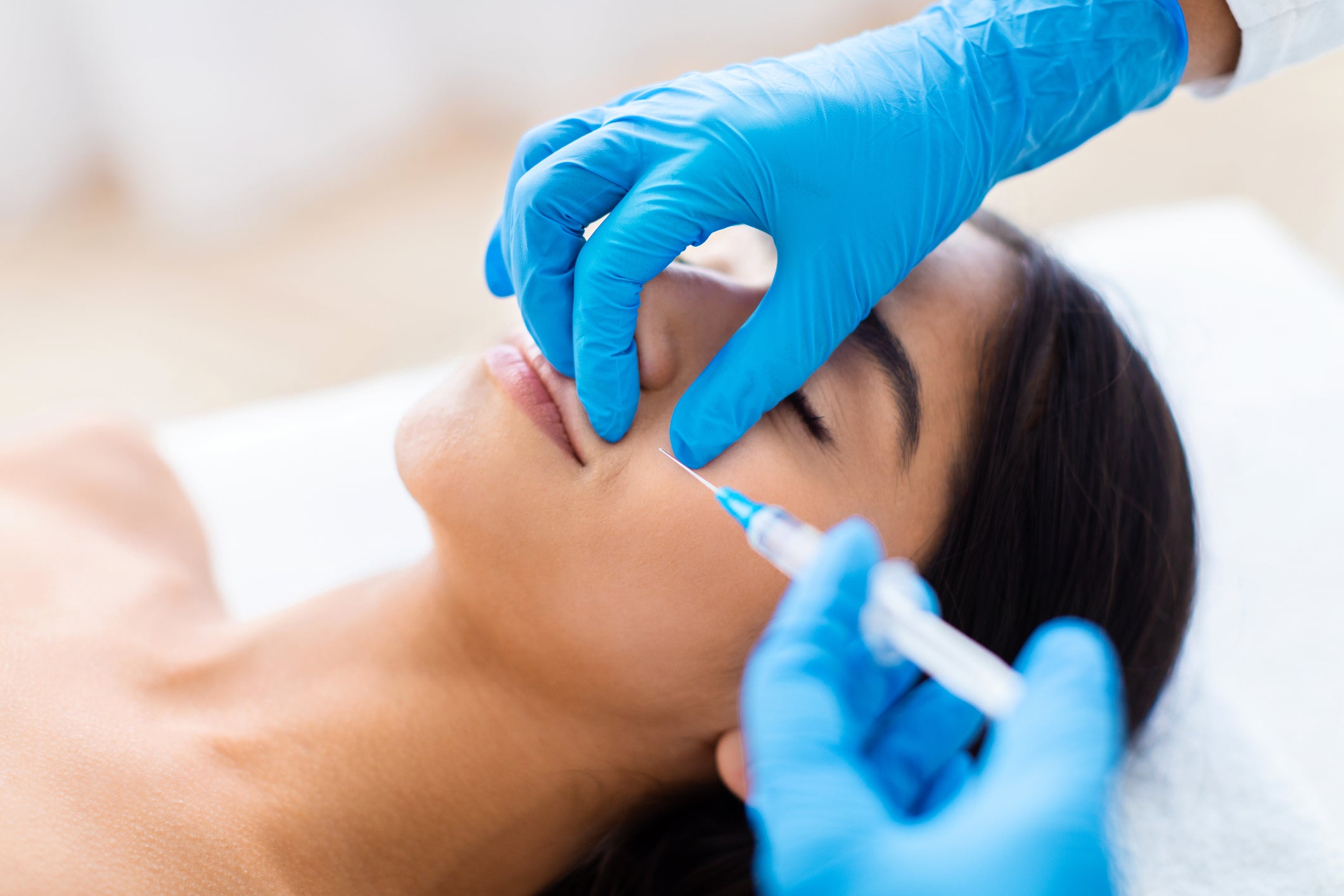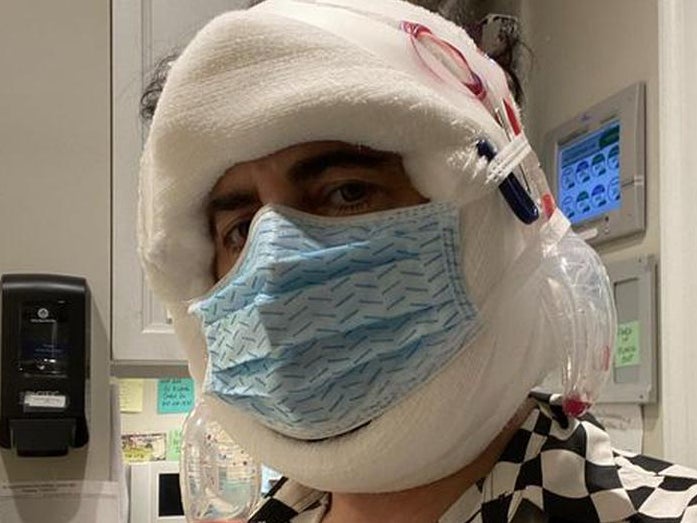Is filler over? The era of the ‘quiet’ facelift is definitely in
Stealthy, subtle facelifts are on the rise, and it’s not just celebrities who are going under the knife. Katie Rosseinsky explores why younger patients are being drawn to this intense procedure


Your favourite celebrity has just arrived on the red carpet, and there’s something ever so slightly different about their face. Their cheekbones are lifted and their jawline is sleeker than ever. They look youthful, but not uncannily so. It’s not so much a dramatic “before and after” transformation; instead, they still appear like themselves, but a minimally tweaked, glown-up version. Still, their makeover is almost certainly more than just some different blush placement and a fresh hairstyle.
It’s a scene that seems to have played out time and time again over the past year or so. And although the stars in question tend to keep schtum about any rumoured procedures (as is their prerogative), that only spurs on the social media sleuths to speculate over what exactly it is they might have “had done”. In many cases, those sleuths reach the same conclusion: it’s a facelift, right?
That conclusion might seem like a surprising one, because the term facelift once summoned up images of tighter-than-tight skin and permanently alarmed features. The treatment felt old school, beloved by black-and-white film idols. It certainly didn’t seem like something that present-day Hollywood stars, in their forties or even late thirties, would be queuing up for, with other, seemingly more subtle treatments at their disposal.
But techniques – and the results they can achieve – have improved dramatically over the past few decades. Now a patient should end up looking radiant and rejuvenated, rather than overly stretched and perma-shocked. Often the only tell-tale sign is a tiny incision mark around the ear; not for nothing are some treatments being described as quiet or invisible.
Indeed, undetectability is something of a status symbol (it also surely makes the online surgery sleuth’s guessing games both more tenuous and more irresistible). “I think that there’s an increasing trend where people want to just feel and look refreshed, like they’ve had a good night’s sleep,” says London-based consultant plastic surgeon Dr Kshem Yapa. “But they don’t want to necessarily look like they’ve had surgery, certainly, and don’t want everyone to know that they’ve had something done.”
It’s not just celebrities that are seemingly going under the knife. This month, the annual audit from the British Association of Aesthetic Plastic Surgeons (BAAPS) revealed that the number of face and neck lifts performed by their members increased by 8 per cent in 2024. Brow lifts, which focus on the eyebrows and forehead, also rose by 20 per cent. If those seem like relatively modest increases, bear in mind that in 2022, BAAPS reported a staggering 97 per cent increase in face and neck lifts.
Anecdotally though, what’s particularly striking is the demand from a younger generation of prospective patients. “Facelift requests from anyone under 40 were unheard of up until the last five years,” says consultant plastic surgeon Gerard Lambe, who’s based at the Reflect Clinic in Manchester. Before then, Lambe says, he and his colleagues “would only get consultation requests from patients aged at least 55, and typically for a facelift, the average age group was 60 to 70”. But in the past 12 months, there’s been a 20 per cent uptake in enquiries from potential clients under 40 at his clinic.
When I speak to other surgeons, they tend to echo his comments: they’re now fielding requests from a more youthful demographic. So why are people who’ve barely reached middle age considering such an in-depth, expensive treatment?
Facelift requests from anyone under 40 were unheard of up until the last five years
To grapple with that, first we need to consider the ageing process (buzzkill, I know) and how it might impact our faces. As we get older, our skin inevitably starts to lose volume and becomes more lax, so “the whole face tends to get a bit saggy and slide down”, as Yapa puts it. Some people start to notice the first signs in their mid to late thirties, but “most would not immediately turn to a surgical option to try and rectify that, because obviously, surgery’s potentially scary, with lots of downtime, at least in people’s minds”.

And so, if someone is really bothered about these changes, they might turn to non-surgical procedures instead: think of energy-based treatments using radio frequency, laser or ultrasound technology, or injectables such as hyaluronic fillers. But “the problem is, this only works to an extent”, Yapa says. And, he adds, “if you’re trying to mask changes in [facial] laxity by adding volume” – with fillers, for example – “and you carry on going with that, then you can sometimes start to look overfilled and unnatural”.
Over the past decade or so, injectables have become increasingly popular among people in their twenties. It follows, then, that those same patients are likely to reach that “overfilled” point at a relatively young age; plus, filler might even begin to migrate to a different part of the face. “If people start on that journey quite early, ultimately they’ll realise that it’s not quite working, and then what comes next?” Yapa says. “If you get to [the point] where you have sufficient laxity, and that laxity leads to folds around the mouth and jowls, then the way to get the most natural results is to have a surgical lift to try and put those [facial] tissues back to where they were.”

If you rewind back to the Sixties and Seventies, facelifts tended to be “skin only” procedures. Surgeons would remove excess skin and then tighten up what remained; hence that uncanny, stretched-out appearance. The phrase “windblown” was a common way of politely referring to that look, says Dr Anil Joshi, a consultant plastic surgeon who specialises in facial reconstruction. “Those were the days when [surgeons] were just tightening the skin, pulling it backwards, and it appeared so unnatural,” he explains. But now, he says, the treatment has evolved with a better “understanding of the deeper structure of the face, rather than just the skin”.
The deep plane facelift technique is increasingly popular – it’s pricey, but the end result tends to be more subtle, and to stay truer to, say, what you might have looked like five or 10 years before. Fashion designer Marc Jacobs is one of the handful of celebrities who have gone on the record about their deep plane treatment (in 2021, he documented his recovery on Instagram).
Underneath the skin is a layer of tissue called the superficial musculoaponeurotic system, more snappily referred to as SMAS. This becomes weaker and looser as we age, and in order to really make a difference, surgeons need to delve below this. A deep plane facelift involves repositioning the facial ligaments and tissues; this gives “much more natural-looking results” but doesn’t require as much trauma to the skin, Yapa says. The fact that “the techniques are improving and the outcomes are getting better” has helped change the perception of this procedure, he adds.
Fashion designer Marc Jacobs is one of the handful of celebrities who have gone on the record about their deep plane treatment
But for all the online chatter about “invisible” or “quiet” procedures, we can’t escape the fact that this is a major operation. It still takes a few weeks for the swelling and bruising to subside, and you might need to wait a few months to “start seeing the real value of that surgical work”, says Dr Joshi. It’s no coincidence that many of Hollywood’s major players seem to emerge from 2023’s Sag-Aftra strike with newly radiant visages; the walkout freed up their schedules and gave them the off-camera downtime required to fully recover. “Hollywood elite rushes to get plastic surgery before the strike ends,” one Vanity Fair headline from that summer claimed. Images of their glow-ups have flooded social media since, accompanied by whispers about facelifts; that’s certainly helped normalise the procedure.

There are other potential reasons for the surge in popularity too. Right now, it feels impossible to have a conversation about beauty without referencing the looming spectre of weight-loss drugs. Those who take semaglutide (often known by brand names such as Ozempic or Wegovy) tend to drop pounds rapidly – all over their body. This can leave them dealing with prematurely haggard, saggier skin, making a facelift seem more appealing. “Yes, the Ozempic phenomenon has played a part,” Lambe says. Out of the “small number of younger patients” he has operated on, most of them had “significant loose skin”, some have had loose skin from significant weight loss (in other cases, this was the result of “illness, skin disorders or unlucky genetics”).
The way that we think about getting and looking older has also shifted significantly too (blame social media, blame reality TV, blame any number of factors). Once, even the most beauty-conscious among us would let the signs of ageing actually appear before attempting to “fix” them. Now, prevention is the industry’s watchword. There’s an increasing emphasis on preemptive treatments to ward off wrinkles before they’ve even formed. Just think of the twentysomethings opting for preventative “baby” Botox in the hope that they’ll stop any lines from developing. Or the youngsters adopting intricate, multi-step skincare regimes and asking for anti-ageing retinol creams for their birthdays, when their ages are barely into double figures.
A good surgeon certainly wouldn’t encourage anyone who is stressing out about early signs of ageing to immediately undergo surgery. “If you don’t have facial laxity, then you shouldn’t be having this operation, period,” says Yapa. “I think it’s the responsibility of all surgeons to tell people ‘no, this is not the right time,’” he adds (he notes too, that “the right time for some people will be never – you’re ageing appropriately and normally, you’re embracing the changes and that’s completely fine”).
Unfortunately not everyone is so scrupulous. “I’ve had patients who come to me at 30, 32, saying they need a facelift, and I’ve said, ‘absolutely not,’” Yapa says, only for them to opt for surgery abroad, for example.
I think it’s the responsibility of all surgeons to tell people ‘no, this is not the right time’
Dr Joshi had a similar experience only a few days before we speak, with a client in her early thirties. “There were some unnatural scars on her face, and I asked what they were,” he says. It turned out that “at 28, she’d undergone some kind of facelift in another country”, and she’d been left with visible marks in front of her ears. “If she had come to me, I definitely would have said no to her at the time.” His patient, he adds, had been influenced by images of perfection that she’d seen on social media.
It’s also worth diving into the marketing speak that accompanies major procedures like these. You can describe a facelift as “quiet” all you like, but that doesn’t necessarily make the process any less invasive. “When procedures are oversold as simpler, they’re very easy to market,” says Yapa. He cites the example of the so-called “mini lift”, which involves “a very modest dissection” in order to lift up the SMAS layer, and “one or two sutures”. There’s “a lot of marketing out there that says, ‘well, if you’re coming to it really early, then a mini lift or a SMAS lift is the right operation for you’”, he notes.
But “the problem with that sort of approach”, he says, “is you’re entering the realm of the surgical facelift, but you’re not having an operation that will give you long-lasting results.” You might end up with the same scarring as you would have done with a more involved procedure, too. Ultimately, Yapa adds, “if you’re going to consider a facelift, then think about it as a life event. Give it the respect that’s due and do your due diligence.”
Lambe agrees. “It is vital to understand that the younger [someone] has a facelift, the more likely they may need a top-up, repeat surgery later in life, as even a facelift does not last forever,” he says. “The skin grows and people lose and gain weight – it is not a permanent solution.” A facelift, he says, “should be a last resort for anyone regardless of age” – as “all surgery is a serious business, and being in the best possible hands of an experienced, insured and responsible surgeon is essential”.
Join our commenting forum
Join thought-provoking conversations, follow other Independent readers and see their replies
Comments